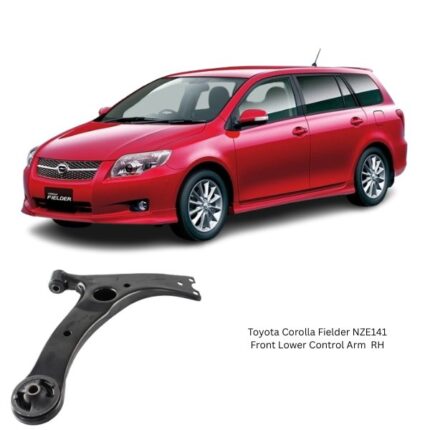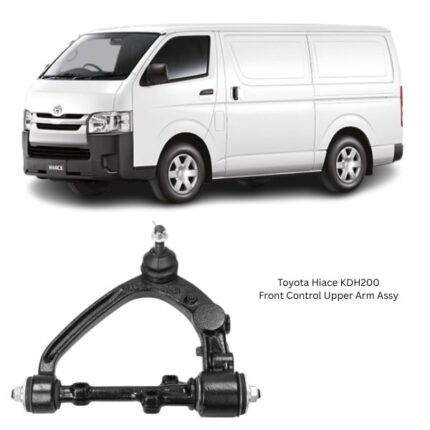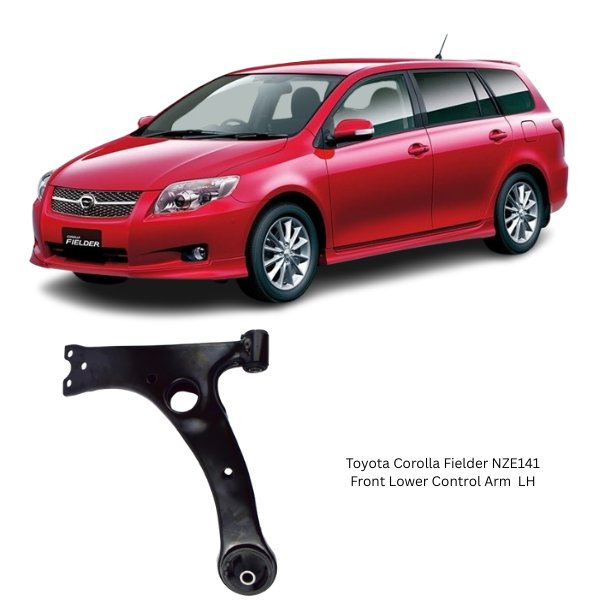Get Toyota Corolla Fielder NZE141 Front Lower Control Arm LH 48069-12220 in Kenya
The Front Lower Control Arm LH (Left-Hand) is a fundamental component in a vehicle’s front suspension system. It plays a crucial role in ensuring stability, comfort, and proper alignment of the wheels while driving. Whether you’re steering through corners, accelerating on straight roads, or driving over uneven terrain, the control arm works silently behind the scenes to keep everything connected and in control.
1. What is the Front Lower Control Arm LH?
The Front Lower Control Arm LH refers to the control arm located on the left-hand (driver’s) side of a vehicle’s front suspension system. It serves as a link between the vehicle’s frame or subframe and the front steering knuckle, allowing the front wheel to move up and down while keeping it aligned and properly positioned.
This component typically has a triangular or L-shaped design and is mounted to the chassis with bushings and to the steering knuckle via a ball joint. It is engineered to withstand considerable stresses, including impacts from potholes, vibrations from road surfaces, and forces generated during braking and cornering.
2. Primary Components of the LH Lower Control Arm
The Front Lower Control Arm LH comprises several subcomponents, each playing a specific role in suspension dynamics:
-
Arm Structure: Made from durable materials like forged steel, cast iron, or aluminum to balance strength and weight.
-
Bushings: Rubber or polyurethane mounts that absorb road shock and reduce vibration; these connect the control arm to the chassis.
-
Ball Joint: A spherical bearing that links the control arm to the steering knuckle and allows for rotational movement.
-
Mounting Points: Locations where the control arm bolts to the subframe or crossmember.
3. Functions of the Front Lower Control Arm LH
a) Maintains Wheel Position
The control arm keeps the wheel aligned relative to the vehicle’s body, ensuring correct toe, caster, and camber angles.
b) Enables Suspension Movement
It permits the wheel to move vertically over bumps while limiting unwanted forward or backward motion.
c) Absorbs Road Impact
The control arm and its bushings help absorb shocks from road imperfections, contributing to ride comfort.
d) Supports Steering Dynamics
Through the ball joint connection, it allows for smooth articulation when the driver turns the steering wheel.
4. Benefits of a High-Quality Front Lower Control Arm LH
-
Enhanced Vehicle Handling: Maintains optimal wheel alignment and tire contact, improving cornering and steering response.
-
Improved Comfort: Bushings reduce the transmission of road vibrations into the cabin, ensuring a smoother ride.
-
Reduced Tire Wear: Maintains proper suspension geometry to prevent premature or uneven tire wear.
-
Increased Durability: A well-manufactured control arm resists wear, corrosion, and fatigue under extreme conditions.
-
Quiet Operation: Quality components operate silently without clunks or rattles during operation.
5. Symptoms of a Faulty LH Lower Control Arm
A worn or damaged Front Lower Control Arm LH can lead to several performance and safety issues:
-
Clunking Noises – Especially noticeable when driving over bumps or during sharp turns.
-
Steering Wheel Vibration – Caused by excessive play or looseness in the suspension.
-
Vehicle Pulling to One Side – Resulting from alignment issues due to faulty bushings or a bent control arm.
-
Uneven Tire Wear – Misaligned wheels wear tires faster on one edge.
-
Poor Handling – A loose or worn control arm can cause instability or imprecise steering response.
6. Causes of Damage or Wear
-
Natural Aging and Use: Over time, bushings dry out, crack, or deform, and ball joints lose lubrication.
-
Road Conditions: Repeated exposure to potholes, curbs, or rough roads increases stress on suspension components.
-
Accidents or Collisions: Even minor impacts can bend or damage a control arm.
-
Corrosion: In climates with moisture or road salt, rust can weaken metal components.
-
Heavy Loads: Overloading the vehicle beyond its intended capacity accelerates wear.
7. Replacement Process for Front Lower Control Arm LH
While replacement varies slightly depending on vehicle make and model, the general steps are consistent.
Tools Needed:
-
Jack and jack stands
-
Lug wrench
-
Wrenches and sockets
-
Ball joint separator
-
Torque wrench
Steps:
-
Safety First: Park on a flat surface, engage the handbrake, and use wheel chocks.
-
Lift the Vehicle: Use a jack to lift the front end and secure it with jack stands.
-
Remove the Wheel: This provides access to the suspension assembly.
-
Detach Ball Joint: Use a separator to disconnect the ball joint from the steering knuckle.
-
Unbolt Control Arm: Remove bolts securing it to the chassis or subframe.
-
Install New Arm: Position the new arm, reattach bolts and ball joint, and torque them to manufacturer specifications.
-
Reinstall Wheel and Lower Vehicle
-
Alignment Check: It’s essential to have a wheel alignment after control arm replacement to restore suspension geometry.
8. Maintenance Tips for Longer Lifespan
-
Regular Visual Inspections: Check for cracks, torn bushings, or rust during routine service.
-
Lubricate When Applicable: Some ball joints are greasable; lubricate as recommended.
-
Avoid Potholes and Rough Terrain: Drive cautiously on rough roads to prevent unnecessary suspension stress.
-
Wash Undercarriage: Especially after driving on salted roads, to prevent corrosion.
-
Replace in Pairs When Necessary: If one control arm fails, the other may not be far behind.
9. Differences Between LH and RH Control Arms
Though they perform the same functions, the LH (Left-Hand) and RH (Right-Hand) control arms are not interchangeable due to:
-
Symmetry: Each arm is specifically shaped to fit one side.
-
Bushing and Joint Orientation: The angle and position of bushings and ball joints differ.
-
Suspension Geometry: Designed to complement the alignment settings on their respective sides.
Always confirm compatibility with your vehicle’s specifications before purchasing or replacing the component.
Follow us on Facebook for more parts.





Reviews
Clear filtersThere are no reviews yet.